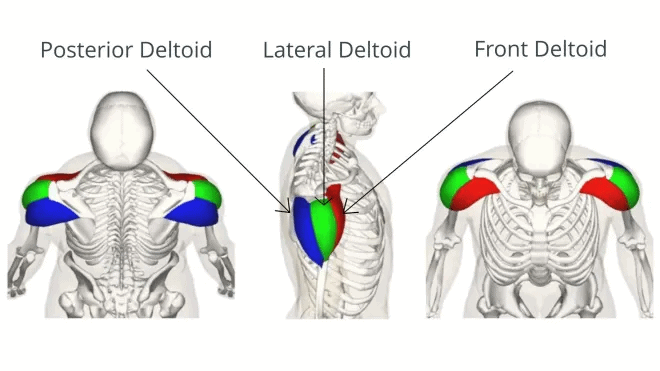The dumbbell shoulder fly is an exercise targeting the shoulder and upper back muscles. It is also known as a lateral raise or lateral deltoid raise.
The dumbbell lateral raise or flying shoulder is one of my favorite shoulder exercises because this exercise is more for shaping and is not necessarily for building or increasing size.
Because every time you pick up a dumbbell and move your arms away from the center of your body, the weight gets heavier as you go up.
The weight is even heavier when you reach the top of the movement. So with this exercise, the one essential thing you need to remember is control, move slowly up to the top and ensure your wrist is always facing the ground and not facing up.
You always want to keep your wrist facing down. Your wrist needs to face down to keep the load on the muscle because the load is coming from the bottom to the top.
Once you turn your wrist up, you’re changing the load. And what’s going to happen here? You’re going to use your forearms, and you’re going to use your bicep more than using your shoulders.
What Muscles Do Dumbbell Lateral Raises Work?
Dumbbell shoulder flys work on our shoulders or our deltoids. More specifically, the lateral deltoid (at the side). Below is an illustration of the different shoulder muscles. We’ve got three, anterior deltoid (In front), lateral deltoid (at the side), and posterior deltoid (behind).

- Dumbbell shoulder flys are a powerful exercise that mainly targets our shoulders, specifically the deltoid muscles.
- Let’s delve deeper into understanding the deltoid muscle group and how this exercise impacts them.
Anatomy of the Deltoid Muscles
The deltoid muscle group, often simply referred to as ‘delts’, is divided into three distinct segments. Each segment plays a specific role in shoulder mobility:
Anterior Deltoid (Front):
- Located at the front of the shoulder.
- Responsible for shoulder flexion, or raising the arm forward.
- Often engaged in pressing movements and front raises.
Lateral Deltoid (Side):
- Positioned on the side of the shoulder.
- Its primary function is shoulder abduction, which means lifting the arm to the side.
- The dumbbell shoulder flys specifically target this segment, enhancing its strength and definition.
Posterior Deltoid (Rear or Behind):
- Found at the back of the shoulder.
- It plays a key role in shoulder extension or moving the arm backward.
- Commonly engaged in reverse flys and rowing movements.
Importance of Targeting All Deltoid Segments
- While dumbbell shoulder flys primarily focus on the lateral deltoid, it’s crucial to incorporate exercises that target all three segments of the deltoid muscle group for balanced shoulder strength and aesthetics.
- Balanced deltoids also contribute to proper shoulder joint health and can prevent potential injuries.
Incorporating Dumbbell Shoulder Flys into Your Routine
- Dumbbell shoulder flies can be seamlessly integrated into any shoulder workout regimen.
- As they primarily engage the lateral deltoids, pairing them with exercises that target the anterior and posterior deltoids ensures comprehensive shoulder development.
Always start with lighter weights when doing these shoulder flys and work your way up because you want perfect form. It’s also really easy to get shoulder injuries in the gym and harder to return from a shoulder injury.
How to do Dumbbell Flying Shoulder
I’m going to show you guys how to do dumbbell raises. Dumbbell shoulder flys will target your rear delts and a few traps.
- Holding the Dumbbells 1
So you want to grab some dumbbells, stand up straight, and start this exercise one of two ways; holding the dumbbells in front of you and then lifting them or
Just start them off by your side and lift them straight up. - Holding the Dumbbells 2
I like to start the dumbbell shoulder flys by my side, though It doesn’t matter which way you start; as long as while you’re doing the exercise, you’re keeping your shoulder blades pinched the whole time, keep it nice and tight.
- Shoulder Position
With your shoulder blades pinched, keep your wrist straight, bend your knees a little bit, and arch your back to keep your shoulder blades pinched, and you will breathe out as you exert force.
- Lifting the Dumbbells
That means you’re going to breathe out as you go up. And you’re going to bring the dumbbells up just above your neck or where your chin is, then bring it back down.
- Repetitions
Breathe out the way up. Come back down. Breathe out the way up again. Do 5 to 8 reps, keeping everything nice and tight.
- Summary
And that’s how you do dumbbell shoulder fly raises.
Common Questions
Dumbbell shoulder flys work on our shoulders or our deltoids
Yes, it helps work and shape the lateral deltoids on your shoulders
Shoulder flying hurts because the weight gets heavier as you go up.
Standing dumbbell shoulder flys are more effective for shaping your shoulders
What Are The Common Mistakes During Dumbbell Shoulder Flying?
So the most common mistake that I see is, first of all, too much weight. Too much weight just kills everything. It turns you into a weightlifter rather than a bodybuilder.
Another common mistake I see many people making is the body jerking back and forth. The most important thing about dumbbell lateral raises; keeping your body stable. Once your body jerks back and forth, the load is gone, and there’s no more isolation.
And the more you isolate the muscles in a stable position, the more you will feel the roundness of your shoulders on the side. Because with that roundness, your shoulder property is going to be complete.
- Empowering Transactions: Navigating Firearms Sales with Proper Documentation - April 8, 2024
- Army PRT – Preparation and Recovery 2024 - March 18, 2024
- Active and Reserve Components 2024 - March 6, 2024
